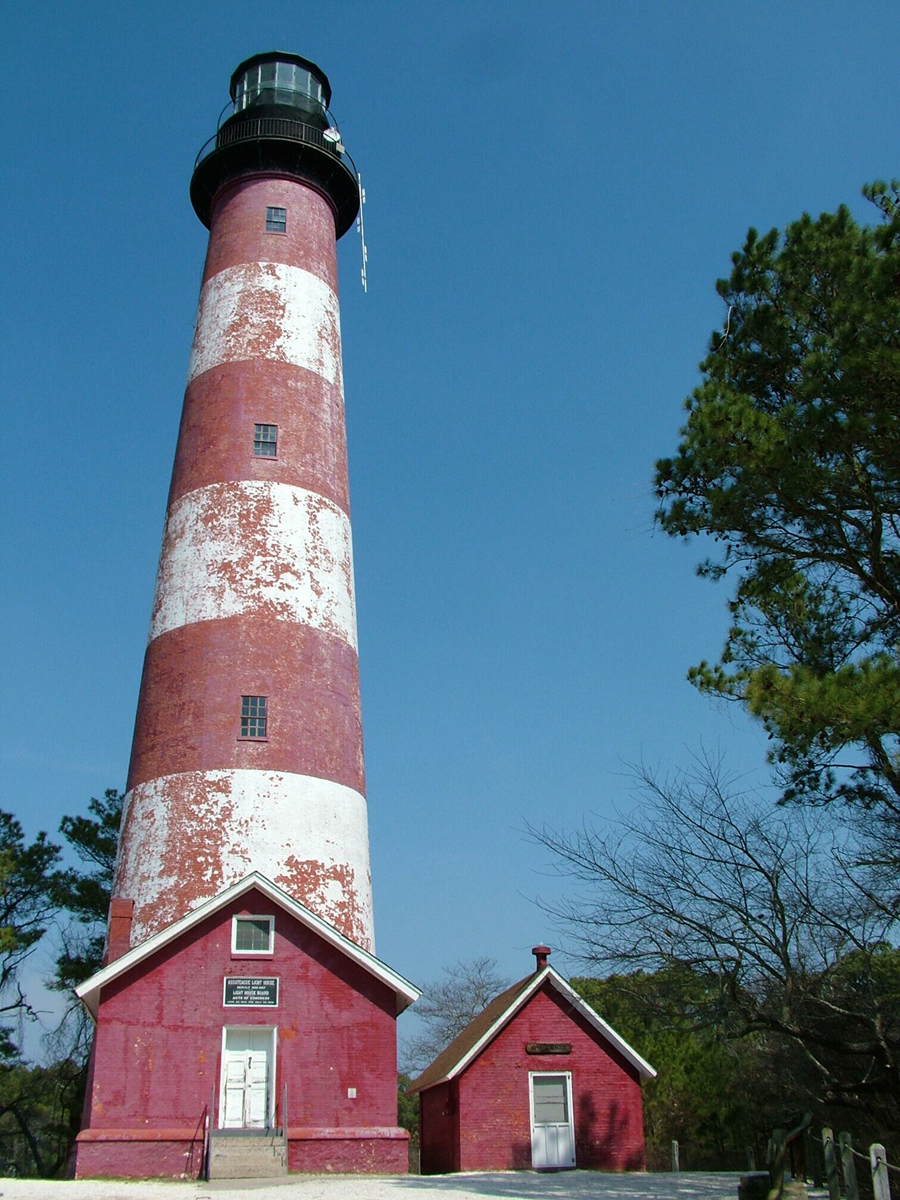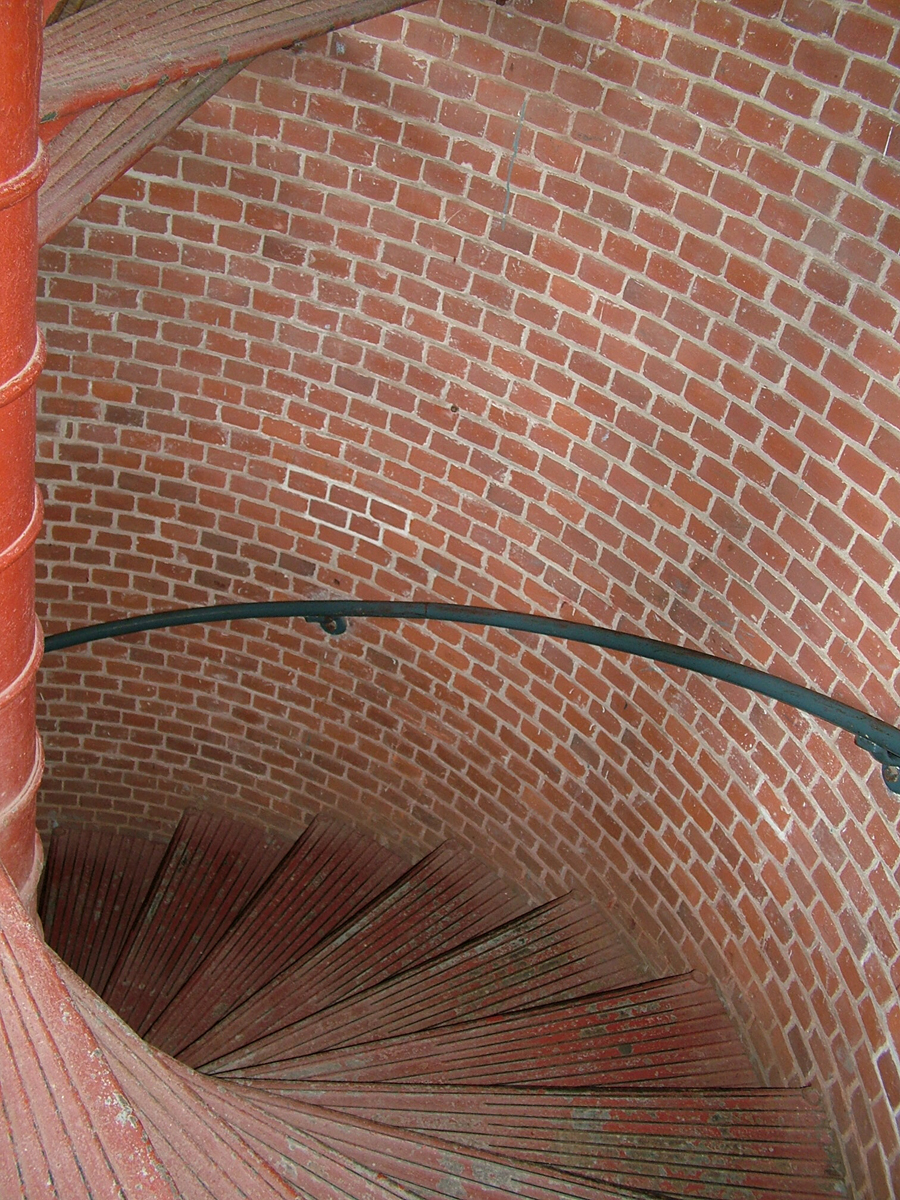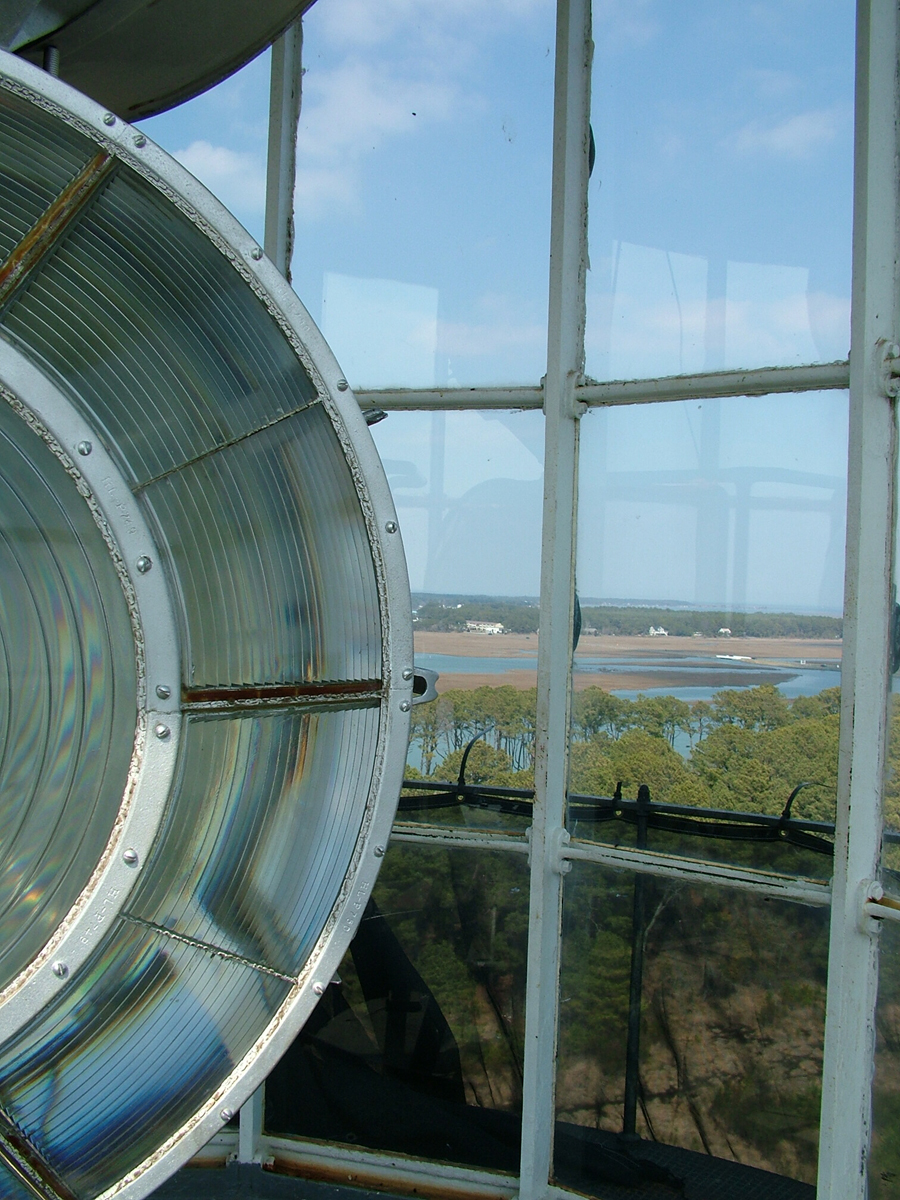CHAPTER 13
Assateague Lighthouse
ASSATEAGUE ISLAND

Years went by. And more years. Changes came to Assateague. The red men came. The white men came. The white men built a lighthouse to warn ships of dangerous reefs. They built a handful of houses and a white church. But soon the houses stood empty. The people moved their homes and their church to nearby Chincoteague Island, for Assateague belonged to the wild things—to the wild birds that nested on it, and the wild ponies whose ancestors had lived on it since the days of the Spanish galleon.
—Marguerite Henry, Misty of Chincoteague
FEW IF ANY PEOPLE lived on Assateague Island, a thirty-seven-mile-long barrier island separating mainland Virginia from the Atlantic Ocean, when a Spanish galleon ran aground off its coast on September 5, 1720, and it is likely that nobody ashore witnessed the wreck. Its arrival, nonetheless, was to have a lasting impact on the history and lore of the island.
La Galga, “The Greyhound,” was one of seven ships in a treasure fleet laden with gold, silver, and other valuables bound from Havana to Cadiz, Spain. When it ran onto the shallows off the coast of Assateague—just two ship lengths from land, according to the testimony of its captain—the crew attempted to lighten it by driving overboard the horses that were part of its cargo. Five of the sailors followed their example, leapt into the sea, and tried to make it to the shore. Since then, the island has been haunted both by the descendants of the horses that managed to swim ashore—and by the ghosts of the Spaniards who did not.
Assateague had had a relatively quiet history up to that point. Indians had come to the island on a seasonal basis to hunt and fish for as long as anyone could remember but had established no permanent communities on the island. The horses were among some of its first fulltime inhabitants in historical times (there being evidence for permanent Clovis culture settlements until about 11,000 years ago). And, sometime in the decade prior to the wreck of La Galga, the pirate Edward Teach—better known as Blackbeard—is believed to have come to the island, and perhaps to have buried some of his ill-gotten treasure there.
By 1764, the number of horses on the island far exceeded the sparse population of perhaps two dozen human inhabitants, most of them herders and fishermen. From about that time onward, people began to tell stories about ghostly presences on the island. Some claimed that the shadowy figures that could be seen moving noiselessly across the dunes on moonlit nights were the shades of Spanish sailors killed in the legendary wreck off their shores. Others believed that the ghosts that haunted Assateague were those of pirates who had fallen afoul of the fearsome Blackbeard and had been slain by him in one of the violent altercations typical among buccaneer crews. Yet others held that the horses, which could be seen slipping wraithlike through the tangled thickets of the island, were the reincarnated spirits of those who had died on the island.
About one hundred years after the horses arrived, the U.S. government decided that the mid-Atlantic coastline was not adequately protected from offshore hazards—the nearest lighthouses being the ones at Cape Charles, Virginia, nearly seventy miles to the south and Cape Henlopen, Delaware, about eighty miles to the north—and that the dangerous, knife-like shoals off the shores of Assateague required that a lighthouse be built on the island.
Assateague’s first lighthouse, a cylindrical white brick tower some forty-five feet high, twenty-two feet wide at its base, and ten-and-one-half feet wide at its crown, was built in 1833 and became active on May 5 of that year. It was lit by a “Lewis Lamp,” consisting of eleven oil-burning lamps that, with a series of fourteen-inch reflectors, were mounted in a chandelier-style arrangement. A two-room brick house for the keeper was constructed in conjunction with the lighthouse.
Seven years after it began operating, Assateague’s first lighthouse keeper, David Watson, who had tended the tower by himself since it had been commissioned, died under circumstances that to this day are still somewhat unclear. Some believe that his spirit lingers yet at the site, automatically continuing in death the unchanging routines he followed in life. However, since the tower he tended has been replaced with a much larger one, one could wonder whether the shade might not be confused or even irritated by his altered surroundings.
Indeed, Assateague’s first lighthouse was almost immediately deemed to be inadequate, and at its fairly short height was unable to project a warning beam far enough out to sea to warn mariners of shoals that extended out as far as twelve miles. An 1852 report by the Lighthouse Board recommended that it be replaced as soon as possible. Government did not move very quickly in that era, however, and, by the time the Civil War began nine years later, all that had been accomplished was the construction of a wharf and a plank road. Further work was suspended until resolution of the conflict between North and South.
Supported by a U.S. Navy base on a nearby island, Union troops were stationed on the island and guarded the lighthouse from the depredations of Confederate saboteurs. The area was, by all accounts, a hotbed of naval intrigue throughout the war and the military presence was by no means extraneous.
“The British would actually sail ships into the north section and down Chincoteague Harbor, where they would meet Confederate troops, retrofit the ships, and leave as Southern battleships,” Jerry Prewitt, proprietor of the 1848 Island Manor House on nearby Chincoteague Island, told me when we chatted about the history of the area.
Construction of the new lighthouse began the year after the war ended and it was completed, along with a new duplex keeper’s bungalow, in 1867. In the process, the older structure was torn down and probably incorporated into the foundations of the new one. Two keepers were assigned to this larger lighthouse (a number that was increased to three in 1876 and then four in 1909, and decreased to three in 1918 and then two again in 1922; in 1933, the lighthouse was automated and remains so today, requiring no keeper).
The new lighthouse was 142 feet high and was originally covered with a brick-colored cement wash that was replaced by the U.S. Coast Guard with its current distinctive red-and-white striped pattern in 1968.
For its light, Assateague’s new lighthouse was equipped with a powerful array of crystals called a Fresnel lens—a marked improvement over the somewhat second-rate system that had served the earlier lighthouse—that was classified as “first-order,” meaning that it was of the largest sort available (by comparison, the previous light had been a third-order lens).
A village grew up north of the lighthouse at the base of the dunes, where it was protected from storms and wind. It consisted of perhaps three dozen dwellings, most of them relatively primitive wood-framed structures on brick pilings. A school was built for the required minimum of forty students in 1890, and the Union Baptist Church of Chincoteague opened a meeting house for Wednesday services in 1919. Most of the village’s inhabitants earned a living by clamming, fishing, or oystering, and some worked at a short-lived fish-processing plant during the period 1912 to 1928.

A spiral staircase provides access to the various levels of the 42-foot-tall Assateague Lighthouse.
Assateague Village began to decline from about 1922 onward, when amenities like electricity, telephone, and public water became available on Chincoteague and began luring people away from the island. Contributing to dissatisfaction with life on Assateague was Samuel B. Field, a major property owner who made it difficult for inhabitants to move around the island by preventing them from crossing his land. When the lighthouse was automated in 1933 and its keepers left, the last of the villagers followed suit, leaving behind just a couple of die-hards.
Except for a few inhabitants, like Field, Assateague was once again the realm of horses and ghosts and would have felt nearly as mysterious and isolated as it had in decades past, until a bridge was built out to it from Chincoteague in 1962, and tourists began to visit it in the summer and on weekends. The island remains hauntingly wild and beautiful even to this day, and it is easy to imagine that the spirits of those who have lost their lives upon its shores might yet lurk within the tangled copses of its forests or drift on starry nights along its silvery dunes.
“The area around the wreck of La Galga is very eerie,” John Amrhein, author of The Hidden Galleon, a book about the wreck of that Spanish ship, told me when we discussed the subject of ghosts on Assateague. “Five people died, not on ship, but drowned coming ashore.”
“During my many visits and while writing the book I always felt that I was being watched and helped,” Amrhein said of his extensive research. “The captain and crew want their story to be told.”
It would be fair to say that my wife and I certainly felt that a mysterious presence might be nearby during our visit to Assateague in March 2008. It was then prior to the start of the tourist season, and we did not encounter very many other people during our stops at the island’s various visitors’ centers or our hike along its seashore or wooded trails, from which we were able to spot small herds of the feral horses for which Assateague is most famous.

Although automated and unmanned, Assateague Lighthouse is still operational today. Nearby Chincoteague Island can be seen through the window.
Our visit to the island also took place before the lighthouse was open to the public for the year, but we were fortunate enough to make the acquaintance of Laurel Wilkerson, a ranger with the U.S. Fish and Wildlife Service who works at its facilities on the island. Her agency, in conjunction with the Coast Guard, administers the site, and she graciously agreed to give us a tour of the lighthouse and told us a great deal about the history of both it and the island.
One of the first things we wondered about was why the lighthouse is located so far from the Atlantic shoreline, which it is intended to help make more navigable, and the answer she gave was very interesting. In short, barrier islands shift over the years and, depending on the conditions to which they are subjected, can shrink, grow, or change shape. When the lighthouse was built in 1867, it was on a bluff overlooking the Atlantic. Today, it is five miles from the ocean and separated from it by land that did not exist 140 years ago and has gradually built up since that time, much of it now being covered by meadow and woods.
We did not see anything ghostlike during the time we spent in the tower, and nothing strange later turned up in the photographs I took while we were there (although the crawlspace above the entryway was definitely very creepy). But it was an oddly melancholy site, and it was easy to see how a solitary lighthouse keeper might see almost anything during the long hours of watches during the night, or how his spirit might perhaps unconsciously continue its lonely vigil even into the afterlife.
During the years she has worked at Assateague, Laurel said she has not experienced anything definitely paranormal, and she could not say for sure whether or not she believes the lighthouse is haunted. She did say, however, that some odd things have been known to happen at it. One thing that occurred a number of times just prior to our visit, for example, involves the entrance to the tower, for which there are only a few strictly accounted-for sets of keys and which the Coast Guard and Fish and Wildlife Service personnel make a stringent effort to keep locked. Nonetheless, despite their best efforts, this door is often found inexplicably unlocked or open.
Who is more mystified and annoyed—the staff members who have to keep locking the door or the shade of a former lighthouse keeper, perhaps that of keeper David Watson himself, who keeps unlocking it—is an open question.